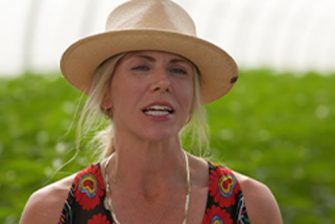EarthScout is partnering with University of Minnesota agricultural scientist Dr. Vasudha Sharma and local corn grower Grant Anderson to research the benefits of variable rate irrigation for conserving water. Grant operates Anderson Farms, an 8000 acre farm in Minnesota with roughly 100 center pivot irrigation systems.
“I’m part of the fifth generation to operate Anderson Family Farms in Belgrade, Minnesota, here. Together with my uncle and two brothers, we have a fair to finish hog operation and a beef finishing operation. As well as over 8000 acres of center pivot irrigated cropland that we raise corn and edible food grade kidney beans, dark and red light red kidney beans and sugar beets on.” said Grant Anderson.
“So variable rate irrigation is a precision Ag technology in which we put the right amount of water at the right time, at the right location. So this technology allows us to use the inherent variability that exists in the field in terms of soil type, in terms of topography, elevation and other things that exist in the field and apply only that much is required.” said Dr. Sharma.
Dr. Sharma selected a 120 acre field that had a variety of soil types and elevations and divided the field into eight zones. Within each zone two EarthScout soil cubs were buried to measure soil moisture real time. The data from the zones was gathered and a prescription map was created and used to dial in the irrigation system.
“Variable rate irrigation and the center pivot you see behind me is equipped with that. It’s the ability to turn the sprinklers on or off, depending on where they’re out in the field. So certain areas of the field might need more water and certain areas of the field need less and certain areas almost need no water. They’re close enough to the ground water that we don’t need to irrigate them at all. Variable rate irrigation allows us to use the water more efficiently and put it where it needs to be in the field.” said Grant Anderson.
The studies show that variable rate irrigation, when combined with real time data from wireless soil moisture meters, can help irrigators map and deliver the ideal amount of water across fields with variable elevation, moisture levels and soil characteristics. In addition, the study showed that real time soil moisture data can save center pivot irrigators significant money on fuel and energy costs, regardless of whether they used a variable rate irrigation system.
Before using EarthScout, Grant spent an average of $5 per inch of water per acre on fuel and electricity to power his irrigation systems. This came out to around $75 per acre each year. Using EarthScout Wireless soil moisture meters he was able to reduce irrigation by 30% to a safe level for healthy crop growth, just above the wilting point. This resulted in a savings of $25 an acre, with EarthScout in his first season of use, with a total savings of $3,000 for every 120 acre field.
“The water in Minnesota is a resource that we’re free to use, but there are pumping costs associated with it and electricity costs associated with it. So it’s a money saving thing as well. We’re able to, first of all, utilize the water more efficiently, but also save money and save expenses on the bottom line. But at the end of the day, it comes down to the ROI. It’s got to show a profit. We’re not going to buy the sensors and all the equipment if it doesn’t show a return to us. So those products show a return to us by helping us use the rest of the resources more efficiently and EarthScout and their products have been right there to help us make those decisions and implement those tools to our best use.” said Grant Anderson.
Growers in Western states who pay for water could see additional savings as well.
Contact EarthScout and get a quote today.







